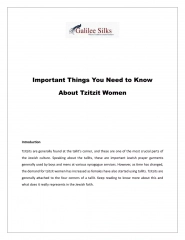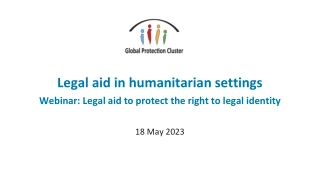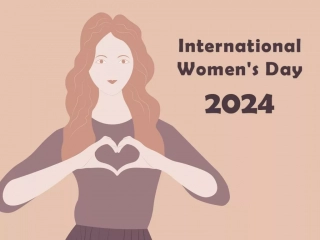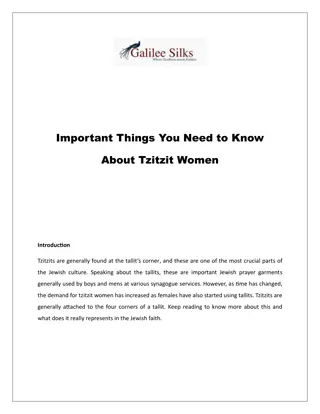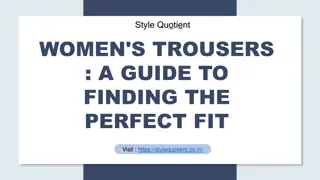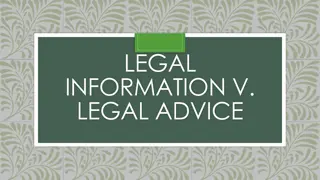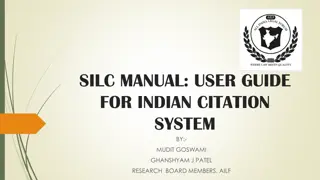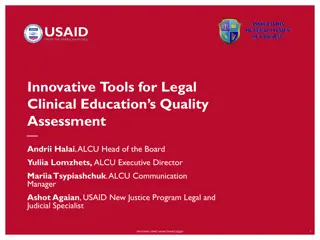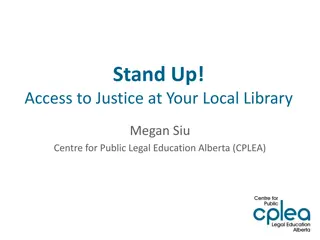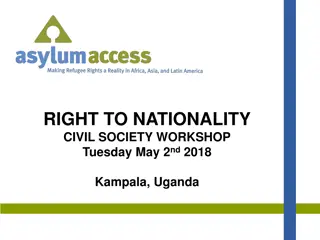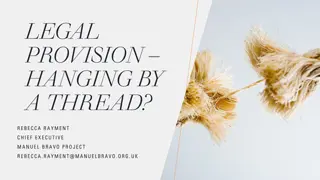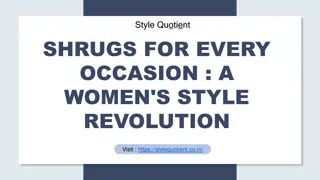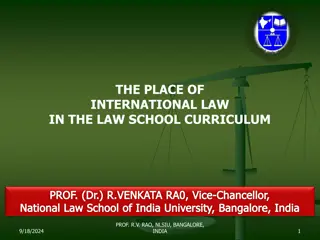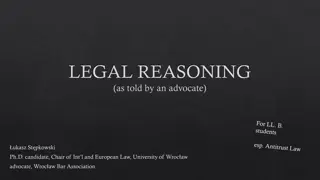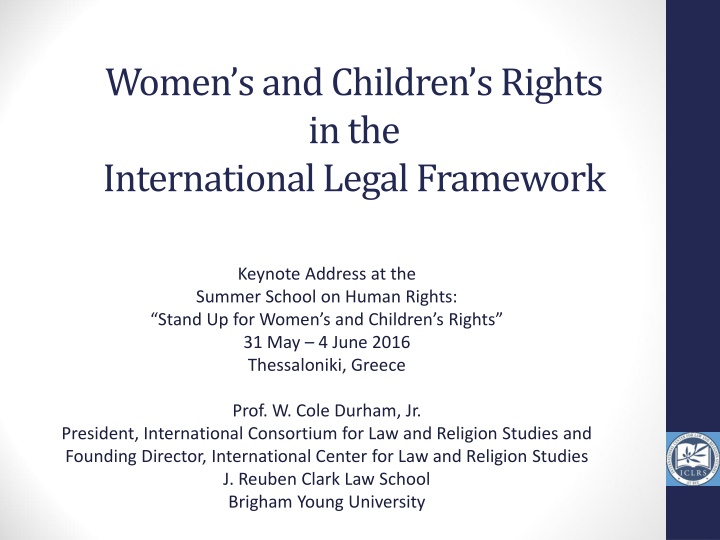
International Framework on Women's and Children's Rights
Explore the international legal framework surrounding women's and children's rights, with insights on religious freedom correlations, the role of religion in promoting human rights, and the importance of wise and sensitive religious voices in addressing human rights issues. Key international human rights instruments are discussed with a focus on children's rights and a gender perspective on women's rights, emphasizing the pluralistic grounding that makes the framework universal yet particular to various religious and cultural traditions.
Download Presentation

Please find below an Image/Link to download the presentation.
The content on the website is provided AS IS for your information and personal use only. It may not be sold, licensed, or shared on other websites without obtaining consent from the author. If you encounter any issues during the download, it is possible that the publisher has removed the file from their server.
You are allowed to download the files provided on this website for personal or commercial use, subject to the condition that they are used lawfully. All files are the property of their respective owners.
The content on the website is provided AS IS for your information and personal use only. It may not be sold, licensed, or shared on other websites without obtaining consent from the author.
E N D
Presentation Transcript
Womens and Childrens Rights in the International Legal Framework Keynote Address at the Summer School on Human Rights: Stand Up for Women s and Children s Rights 31 May 4 June 2016 Thessaloniki, Greece Prof. W. Cole Durham, Jr. President, International Consortium for Law and Religion Studies and Founding Director, International Center for Law and Religion Studies J. Reuben Clark Law School Brigham Young University
Religious Freedom Correlations Brian J. Grim and Roger Finke, The Price of Freedom Denied (2011) 206
Religion and Human Rights Louis Henkin: all the major religions proudly lay claim to fathering human rights. Abba Hillel Silver: Religion was not only tardy in championing human rights; at times it was actually retarding and reactionary. 13 Robert Traer: Clearly, something new is occurring when women and men of different faith traditions join with those of no religious tradition to champion human rights. World Council of Churches played a vital role in the struggle for human rights from the inception.
Ambivalence of Religious Attitudes Religious traditions support core notions of human rights. But, the rhetoric of rights has often been leveled against religious traditions. The ambivalence of the sacred results in differing attitudes toward religion, matched by different responses Attitude of Catholic Church to human rights rhetoric after French Revolution Response of Muslims in many parts of the world Where human rights are experienced as an attack on religion, human rights lose credibility in the religious community attacked. Where resources within religious traditions are shown to support human rights precepts, support for those precepts is strengthened.
Need for Wise and Sensitive Religious Voices Addressing Human Rights Issues Need to find ways that accommodate distinctive religious concerns and beliefs while respecting others. Need to promote mutual understanding. Need to find ways that people with very different beliefs can live together in peace.
Framework Overview of key international human rights instruments Pluralistic grounding of the international framework This helps make human rights framework both universal and particular Universal in that it applies to all mankind (and womankind) Particular in that it can be justified for reasons that make sense to different religious and cultural traditions Children s rights Women s rights (gender perspective)
P.C. Chang and the U.N. Human Rights Commission P.C. Chang and Charles Malik All human beings are born free and equal in dignity and rights. They are endowed with reason and conscience and should act towards one another in a spirit of brotherhood. Article 1 of the Universal Declaration of Human Rights
Four Crucial Delegates & Eighteen Nations Two intellectual polestars of the declaration: P.C. Chang: Chinese philosopher, diplomat, and playwright, and vice-chairman of the commission. Charles Malik: Lebanese philosopher and diplomat - Secretary of the commission. A legal architect: Rene Cassin: The legal genius of Free France. A powerful personality: Eleanor Roosevelt: Former American first-lady. Chairman of the Commission The 18 Nations on the Commission on Human Rights: Australia, Belgium, Chile, China, Egypt, France, India, Iran, Lebanon, Panama, Philippines, the Soviet Union, the United Kingdom, the United States, and Yugoslavia.
The Drafting Committee P.C. Chang and Eleanor Roosevelt 18-member delegation found drafting an international bill of human rights difficult because of enormous political and social obstacles. So the commission chose Roosevelt, Chang, Malik, and John Humphrey to prepare a preliminary draft.
Drafting Process Existing norms Consensus not theory Malik: Yes, we agree about the rights, but on condition no one asks us why. Sovereign state s treatment of their own citizens not only a domestic matter. Shift from minorities approach to protection of individuals
Fundamental Provisions of UDHR: Article 1. All human beings are born free and equal in dignity and rights. They are endowed with reason and conscience and should act towards one another in a spirit of brotherhood. Article 2. Everyone is entitled to all the rights and freedoms set forth in this Declaration, without distinction of any kind, such as race, colour, sex, language, religion, political or other opinion, national or social origin, property, birth or other status. . . . . Other articles (5-28) list specific freedoms: e.g., right to life, liberty and security of person; no one shall be held in slavery; slave trade forbidden; anti-torture provisions; equality before the law; right to effective remedies; procedural rights; freedom of religion, expression, association; social and economic rights.
Limitations: Article 29 1. Everyone has duties to the community in which alone the free and full development of his personality is possible. 2. be subject only to such limitations as are determined by law solely for the purpose of securing due recognition and respect for the rights and freedoms of others and of meeting the just requirements of morality, public order and the general welfare in a democratic society. In the exercise of his rights and freedoms, everyone shall 3. contrary to the purposes and principles of the United Nations. These rights and freedoms may in no case be exercised
The Deeper Framework A free, liberal, and democratic state can only be built and sustainable on a foundation that it in itself is unable to create. --Ernst-Wolfgang B ckenf rde Former Justice German Federal Constitutional Court
Bckenfrde Paradox The tragedy of liberty Other political passions override the desire for liberty Dostoevsky s Grand Inquisitor is a recurrent tale not only at the level of individual moral choice, but also at the level of political freedom Liberty is overridden by other political passions: envy, equality, social and economic rights, sexual liberation, fear, corruption The need for voluntary compliance The need for moral striving to provide the inputs for the vision, convictions and ideas that provide the value inputs for democracy
Pre-Modern Assumptions Religious homogeneity necessary for political stability. It provided: the necessary glue for social coherence and the ultimate motivation for loyalty and obedience to the state. Religious truth demanded state backing of religious beliefs
The Lockean Insight Locke rejected the pre-modern assumptions A Letter Concerning Toleration (1689) State coercion ineffective Cannot force someone to heaven At best extracts hypocrisy Coerced toleration is a source of religious violence rather than peace Respecting difference breeds loyalty, stability and peace
The Role of Dissenting Groups in Forging Religious Freedom Early thinking on religious freedom goes back to Protestant dissenters Significance of figures such as Roger Williams and William Penn Smaller groups understood the need for and framed the arguments in favor of free exercise of conscience.
Freedom of Religion or Belief Article 18 UDHR (later, Article 18, ICCPR): Everyone has the right to freedom of thought, conscience and religion; this right includes freedom to change his religion or belief, and freedom, either alone or in community with others and in public or private, to manifest his religion or belief in teaching, practice, worship and observance.
Article 9 ECHR 1. Everyone has the right to freedom of thought, conscience and religion; this right includes freedom to change his religion or belief and freedom, either alone or in community with others and in public or private, to manifest his religion or belief, in worship, teaching, practice and observance. 2. Freedom to manifest one s religion or beliefs shall be subject only to such limitations as are prescribed by law and are necessary in a democratic society in the interests of public safety, for the protection of public order, health or morals, or for the protection of the rights and freedoms of others.
The Foundational Character of Freedom of Religion or Belief Historically Foundational Philosophically Foundational Institutionally Foundational Empirically Foundational
Current Needs in Protecting Freedom of Religion or Belief Drawing on the strength of the internal resources of religious communities calling for respect for the rights of others. Resisting the persecution syndrome: the tendency of groups to engage in oppressive behavior when they acquire power. Recognizing that secular power is as prone to lead to the persecution syndrome as religious power. Need for a flexible notion of secularity
The Ideological Setting: Secularism v. Secularity Ideology Neutralizing French laicite Freedom from religion Religion consigned to private sphere Rigid Formal Equality Framework Neutrality American separation Freedom of religion Religion accepted in open public sphere Flexible Substantive Equality
Three Limitations (ECHR 9(2)) Rule of Law Constraint Legitimating grounds for limitations Necessary in a democratic society Pressing social need Proportionality 2. Freedom to manifest one s religion or beliefs shall be subject only to such limitations as are prescribed by law and are necessary in a democratic society in the interests of public safety, for the protection of public order, health or morals, or for the protection of the rights and freedoms of others.
Additions to the Framework: Treaties and Treaty Bodies CERD: International Convention on the Elimination of All Forms of Racial Discrimination (1965) ICCPR International Covenant on Civil and Political Rights (1966) ICESCR International Covenant on Economic, Social and Cultural Rights (1966) CERD: Committee on the Elimination of Racial Discrimination HRC Human Rights Committee CESCR Committee on Economic, Social and Cultural Rights
Women and Children Treaties and Treaty Bodies CEDAW Convention on the Elimination of All Forms of Discrimination against Women (1979) CRC Convention on the Rights of the Child (1989) CEDAW Committee on the Elimination of Discrimination against Women CRC Committee on the Rights of the Child
CEDAW Procedures Reporting Individual communications and complaints Inquiries (including country visits)
CRC Procedures Reporting Individual communications and complaints Inquiries (including country visits) Inter-State Complaints General Comments Request for studies of the Secretary-General/Special Representatives of the Secretary-General
Major Womens Issues Child Care and Early Learning Health Care and Reproductive Rights Abortion Birth Control Pregnancy and Parenting Health Care Insurance Coverage
Poverty and Economic Security As a result of employment discrimination, caregiving responsibilities and other factors, women are at greater risk of poverty than men throughout their lives. High risk groups: Single mothers Women of color Elderly women living alone Women are breadwinners, or co-breadwinners in two-thirds of families Need for fair work schedules Need support for unpaid caregiving (children, parents, others) Family tax credits extremely helpful Challenge of unemployment
Challenges in the Workplace Women are still paid only 79 cents for every dollar paid to men. Worse for women of color. Child care workers deserve fair pay and good working conditions Women more than twice as likely as men to be in low wage jobs: child care, restaurant servers, maids, and cashiers. Challenges associated with pregnancy need for fair treatment Sexual harassment in the workplace from derogatory comments to sexual assault Unemployment
Trafficking, Sexual Assault Tragically, these are issues for both women and children Need for appropriate responses Under-reporting
Scope of Trafficking Problem UN estimates that a total of 27 million people are enslaved worldwide. 2.4 million are being trafficked at any given time. 79% are sexually exploited 18% subject to forced labor 80% are women; 50% are children Carried out by extensive and highly sophisticated international crime networks that are increasingly globalized. Highly lucrative: estimated $150 billion per year and growing. Palermo Protocol to UN Convention Against Transnational Organized Crime, adopted in 2000. Underenforced.
Special Issues in Refugee Situations Concern for education of children Healthcare Food and nutrition Shelter Return to normalcy
Issues linked to religious beliefs Unequal succession rules under Shariah Honor killing
Problems with CEDAW More reservations than virtually any other human rights treaty Article 5. State parties shall take all appropriate measures: (a) To modify the social and cultural patterns of conduct of men and women, with a view to achieving the elimination of prejudices and customary and all other practices which are based on the idea of the inferiority or the superiority of either of the sexes or on stereotyped roles for men and women; (b) To ensure that family education includes a proper understanding of maternity as a social function and the recognition of the common responsibility of men and women in the upbringing and development of their children, it being understood that the interest of the children is the primordial consideration in all cases.
Issues linked to religious beliefs Unequal succession rules under Shariah Honor killing
CEDAW Article 5 States Parties shall take all appropriate measures: (a) To modify the social and cultural patterns of conduct of men and women, with a view to achieving the elimination of prejudices and customary and all other practices which are based on the idea of the inferiority or the superiority of either of the sexes or on stereotyped roles for men and women; (b) To ensure that family education includes a proper understanding of maternity as a social function and the recognition of the common responsibility of men and women in the upbringing and development of their children, it being understood that the interest of the children is the primordial consideration in all cases.
CEDAW Article 16 1. States Parties shall take all appropriate measures to eliminate discrimination against women in all matters relating to marriage and family relations and in particular shall ensure, on a basis of equality of men and women: (a) The same right to enter into marriage; (b) The same right freely to choose a spouse and to enter into marriage only with their free and full consent; (c) The same rights and responsibilities during marriage and at its dissolution; (d) The same rights and responsibilities as parents, irrespective of their marital status, in matters relating to their children; in all cases the interests of the children shall be paramount; . . . (f) The same rights and responsibilities with regard to guardianship, wardship, trusteeship and adoption of children, or similar institutions where these concepts exist in national legislation; in all cases the interests of the children shall be paramount; . . . (h) The same rights for both spouses in respect of the ownership, acquisition, management, administration, enjoyment and disposition of property whether free of charge or for a valuable consideration.
Responses: Where possible, find ways to accommodate religious difference. Remember that religious rights have profound significance, and should only be overridden by the most serious considerations. Find a less restrictive alternative when possible
Examples: Martha Minow now Dean of Harvard Law School. Humility is of course a virtue within many religious traditions. It is also central to the liberal commitment at the core of constitutional democracy, though less commonly so seen. The virtue of tolerance at the heart of freedom of speech depends on acknowledging that our truths may be wrong, and should be tested in the marketplace of ideas. . . . Might a gesture of humility offer a thread of commonality even between religious people confident of their faith and civil rights advocates and enforcers, confident of theirs? Respect for the opposing side means not presuming bad faith or idiocy motivates the opponents. Flexibility requires listening and refraining from equating principled views with a required outcome. Humility does not mean self-doubt or doubt about principle, but it does involve restraint and making room for open and respectful exploration of the other point of view. . . . It is in the open and respectful exploration of other points of view that negotiations can identify new, enlarged options.
UN Special Rapporteur Heiner Bielefeldt: Gender Report Reminder that FoRB and gender rights are not necessarily in conflict, and in many areas are mutually supportive Need for a holistic perspective that recognizes that [a]ll human rights are universal, indivisible and interdependent and interrelated. While norms may clash with respect to concrete issues, it is a mistake to assume that that is a thoroughgoing clash at the abstract level. Human rights norms protect people with differing beliefs, not the differing beliefs themselves. FoRB opens religious traditions to questions and debates, which can result in more gender sensitive interpretation of texts.
Gender Report continued: Anti-discrimination norms may collide with autonomy of religious communities in their internal affairs. Need for empirical precision, communicative openness, and normative diligence with a view to doing justice to all human rights claims involved. Female genital mutilation, forced marriage, honor killings, enforced ritual prostitution, or denying girls rights to education: where limitation provisions apply, a religious defense is not sufficient. It can no longer be taboo to demand that women s rights take priority over intolerant beliefs used to justify gender discrimination. Forced conversion and forced marriage: need to avoid forcing women to choose either their religion or freedom and equality.
Hobby Lobby and Recent Cases Portrayed in media as corporations trying to control bedroom practices of female employees. In fact, a very narrow decision, holding that were it is possible both to respect the conscientious beliefs of a closely held corporation AND assure women contraceptive care they desire, religious freedom requires approval of this less restrictive alternative.
Childrens Rights: Children, Parents and the Family The CRC is the most widely ratified of all the Human Rights Conventions. The United States is the only country to have refused ratification. Fears of insensitive interpretation lie behind non-ratification Holistic interpretation could resolve worries.
Concerns about CRC Two mutually supportive but potentially clashing views run through American legal tradition. The Individual Tradition Movement toward political autonomy But until 1960s, children were excluded because of insufficient capacity The Family Tradition Family had responsibility for educating and caring for the young Unit of older societies was not the individual, but the family Common law assumed family was the basic social, economic and political unit Origins of parental rights viewed as more fundamental than property rights, and carried higher levels of responsibility Constitutional Rights of Parents Protecting children against abuse Concern about excessive state intervention in the family
Hazards of Abandoning Children to Their Rights Tendency to simply assume children s rights are essentially incipient adult rights adults in miniature Apply rights rhetoric without sufficient adjustment Children benefit from strong relationship with parents. Liberating them from matrix of family life can be detrimental Who is best situated to assess best interests of the child parents, or state officials? Distinction between rights of protection and rights of choice
Rights of protection: protections against abuse, abandonment, neglect Right not to be imprisoned without due process Rights to property Rights to physical protection Right to education Juvenile justice system
Rights of Choice Abortion (where health of teenage mother is not at risk) Desire to leave family on grounds of incompatibility (no evidence of abuse) Choice rights involve those with serious long-term consequences that have traditionally required parental approval Evolving capacity needs to be taken into account, but allowing premature choices may have lifelong unfortunate effects. Rights to special treatment to protect minors from their own immaturity and to optimize development of mature capacities that are in their best interests. Presumption that capacity exists when it does not can result in abandonment of protections otherwise available.


